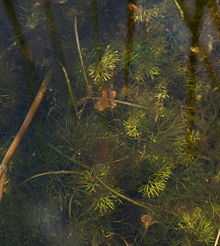Potamogeton berchtoldii
| Potamogeton berchtoldii | |
|---|---|
 | |
| Shoots of P. berchtoldii growing with milfoil and water crowfoot in a pond | |
| Scientific classification | |
| Kingdom: | Plantae |
| (unranked): | Angiosperms |
| (unranked): | Monocots |
| Order: | Alismatales |
| Family: | Potamogetonaceae |
| Genus: | Potamogeton |
| Species: | P.berchtoldii |
| Binomial name | |
| Potamogeton berchtoldii Fieber [1] | |
| Synonyms | |
|
Potamogeton fieberi Rouy Potamogeton groenlandicus Hagstr. Potamogeton lacunatus Hagstr. | |
Potamogeton berchtoldii, common name small pondweed[2] is an aquatic plant.
Description
Small pondweed is a fine-leaved pondweeds with a bushy habit. It lacks a perennial rhizome and the plants die back in winter into a large number of resting buds known as turions. The stems are very slender and do not usually exceed 60 cm.[2] The leaves are flat, usually 25–50 mm long, and less than 2 mm wide, usually with a broad band of lacunae along each side of the midrib and coloured pale green, olive green or brownish green.[2] The open stipules and shining nodal glands can be important characters in identification.
Small pondweed is similar to several other Potamogeton species, especially P. pusillus, and use of a good key such as Preston (1995) is strongly recommended. It could also be confused with P. trichoides and P. obtusifolius.
Hybrids have been described with P. trichoides (P. × franconicus G.Fisch.), P. pusillus (P. × mucronulatus (G.Fisch.) Papch.), P. natans, P. polygonifolius, P. coloratus (P. × lanceolatus Sm.), P. perfoliatus (P. × mysticus Morong), P. natans (P. × variifolius Thore), and P. acutifolius (P. × sudermanicus Hagstr.), but all are rare.[2][3]
Taxonomy
Small pondweed was first named by the German botanist Franz Xaver Fieber in 1838.[3] It is named after the 19th century Czech botanist Friedrich von Berchtold.[4]
This is one of a group of rather similar fine-leaved species that also includes P. pusillus, P. hillii and P. ochreatus.[5] Some authors consider it a form of P. pusillus.[6]
Distribution
Potamogeton berchtoldii is native to Europe (including Britain, Ireland, continental Europe, Scandinavia), the Middle East, North America (Canada, USA), Asia (Bhutan, China, Japan, Kazakhstan, Korea, Tajikistan, Turkmenistan, Russia, Uzbekistan), Asia Minor and the Middle East (Iraq, Iran, Turkey).[1][7][8]
Ecology and Conservation
Potamogeton berchtoldii has a wide ecological tolerance,[9] growing in lakes, ponds, ditches, slow-flowing streams and rivers, temporary pools and sometimes appearing in artificial habitats such as cattle troughs.[2] It is a good colonist and may quickly exploit new habitat.[10][11] The production of large numbers of both turions and seed likely allows it to quickly exploit new or disturbed habitat, but in stable environments it is likely to be outcompeted by more robust plants.
In Britain, small pondweed is common and widespread.[9] It is probably under-recorded due to its relatively small size and confusion with P. pusillus.
Although it does not occur in very acid environments, small pondweed is otherwise tolerant of a wide range of water chemistry and seems able to survive in eutrophic conditions. However, it is less tolerant of high nutrient levels than the related and very similar P. pusillus. It is the only British fine-leaved pondweed likely to be encountered in oligotrophic lakes, where it generally grows in deeper water with Isoetes and Nitella spp.
Cultivation
Small pondweed is not in cultivation, though it is likely to spontaneously colonise new ponds, probably via waterfowl. It is unlikely to persist for long in this environment, however, unless competing plants are regularly cleared. Its small stature and noninvasive habit make it suitable for growing in a pond or aquarium.
References
- ↑ 1.0 1.1 'Potamogeton berchtoldii was first described and published in Oekon.-techn. fl. Böhm. 2(1):277. 1838. GRIN (30 March 2010). "Potamogeton berchtoldii information from NPGS/GRIN". Taxonomy for Plants. National Germplasm Resources Laboratory, Beltsville, Maryland: USDA, ARS, National Genetic Resources Program. Retrieved 22 October 2014.
- ↑ 2.0 2.1 2.2 2.3 2.4 Preston C.D. (1995) Pondweeds of Great Britain and Ireland. BSBI Handbook No. 8. Botanical Society of the British Isles, London.
- ↑ 3.0 3.1 The Plant List: Potamogeton berchtoldii. Royal Botanic Gardens, Kew and Missouri Botanic Gardens. Accessed November 18, 2014
- ↑ Go Botany (New England): Potamogeton berchtoldii
- ↑ Lindqvist C., De Laet J., Haynes R.R., Aagesen L., Keener B.R., Albert V.A. 2006. Molecular phylogenetics of an aquatic plant lineage, Potamogetonaceae. Cladistics, 22, 568-588.
- ↑ Wiegleb G., Kaplan Z. 1998. An account of the species of Potamogeton L. Folia Geobotanica, 33, 241-316.
- ↑ Guo Y., Haynes R.R., Hellquist C.B., Kaplan Z. 2010. Potamogeton. Flora of China, 23, 108-114. http://www.efloras.org/florataxon.aspx?flora_id=2&taxon_id=10726
- ↑ Nobis M., Nowak A., Zalewska-Galosz J. 2010. Potamogeton pusillus agg. in Tajikistan (Middle Asia). Acta Societatis Botanicorum Poloniae, 79, 235-238
- ↑ 9.0 9.1 Preston C.D., Pearman D.A., Dines T.D. (2002) Online Atlas of the British and Irish Flora: An Atlas of the Vascular Plants of Britain, Ireland, the Isle of Man and the Channel Islands: Potamogeton berchtoldii. Accessed 24 December 2014.
- ↑ Ponds Time and Place blog
- ↑ The Garden Pond Blog
| Wikimedia Commons has media related to Potamogeton berchtoldii. |
Template:Monocot